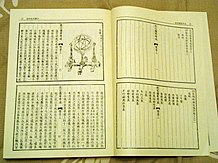
Back تاريخ العلوم والتقانة في الصين Arabic Historia de la ciencia y la tecnología en China Spanish Kiinan tieteen ja tekniikan historia Finnish Histoire des sciences et techniques en Chine French चीन में विज्ञान तथा प्रौद्योगिकी का इतिहास Hindi Tehnologija drevne Kine Croatian Sejarah sains dan teknologi di Tiongkok ID Historio di cienco e teknologio en Chinia IO 中国の科学技術史 Japanese História da ciência e tecnologia na China Portuguese
| Part of a series on the |
| History of science and technology in China |
|---|
 |
| Part of a series on the |
| History of China |
|---|

Ancient Chinese scientists and engineers made significant scientific innovations, findings and technological advances across various scientific disciplines including the natural sciences, engineering, medicine, military technology, mathematics, geology and astronomy.
Among the earliest inventions were the abacus, the sundial, and the Kongming lantern.[citation needed] The Four Great Inventions, the compass, gunpowder, papermaking, and printing – were among the most important technological advances, only known to Europe by the end of the Middle Ages 1000 years later. The Tang dynasty (AD 618–906) in particular was a time of great innovation.[citation needed] A good deal of exchange occurred between Western and Chinese discoveries up to the Qing dynasty.
The Jesuit China missions of the 16th and 17th centuries introduced Western science and astronomy, while undergoing its own scientific revolution, at the same time bringing Chinese knowledge of technology back to Europe.[1][2] In the 19th and 20th centuries the introduction of Western technology was a major factor in the modernization of China. Much of the early Western work in the history of science in China was done by Joseph Needham and his Chinese partner, Lu Gwei-djen.
- ^ Thomas Woods, How the Catholic Church Built Western Civilization (Washington, DC: Regenery, 2005)
- ^ Agustín Udías, p. 53.